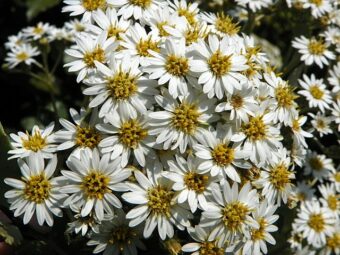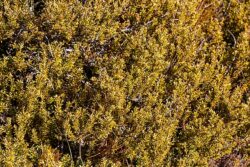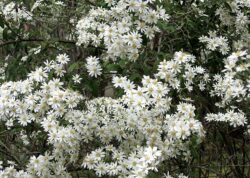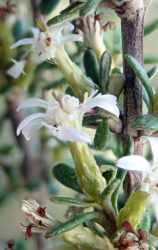In this article, we will discuss how to grow the pretty shrub of Olearia in containers. Olearia, which has the common name of daisy bush, is a genus that belongs to the largest flowering plant of the Asteraceae (the Aster) family, where 180 species are known to exist. Olearias are native to Australia, New Guinea and New Zealand and include shrubs, herbaceous plants and small trees.
They all bear the familiar daisy-like flower heads often seen in members of the Aster family. Olearias are shrubs that either is small or high. The leaves are nothing to write home about as they may be smooth, glandular or produce a sticky secretion, and are opposite or alternate.

The leaves may be sparsely or in clusters with the leaf margins entirely pleated with or without a stalk. On top of these branches, composite flower heads arranged with a single row of petals enclosed with small overlapping bracts appear. The centre of the flowers is a disc shape and can be white, yellow or purple depending on the species and variety. The flowers are nearly always white in petal colour but they can be blue or pink as these varieties also exist.
As said previously the shrub when not in flower is not a thing of beauty as the leaves and shape of the bush are not interesting. The main feature of the shrub is that it is tough and able to grow in exposed sites or in salt-laden air where pollution is a problem. The other consideration is that most Olearias are not really hardy and can survive a harsh UK winter. These are things, you will need to consider before buying a daisy bush.
Find out how to grow Olerias in containers in this article.
GROWING OLEARIA IN CONTAINERS

As they can be a large shrub, you will need to choose a large enough container to support your plant- A half-barrel size is ideal, but make sure it is deep. No matter what you choose make sure it has plenty of drainage holes at the bottom.
To this container add a 2cm layer of gravel to aid drainage. On top of this add up to 5cm below the top rim with a good quality multipurpose compost to which a handful of manure has been added to it.
Dig an aperture in the centre of the container slightly bigger than the root ball it came in the original container you bought it in. drop the plant in so that the top of the root ball is at the same level as the top surface of the compost in the container. Backfill with the growing media, whilst making sure no gaps remain by using more compost if you find it is necessary. Firm the plant in and water well.
THE BEST GROWING CONDITIONS
This is one plant that does well in full sun, the more sun the better it will do. Place the container in a sunny location but away from cold-dry winds. This will take a while to establish and it is best to water when the surface of the compost feels dry to the touch, once established it will take drought pretty well but it is advised to water when 5cm below the top surface of the compost feels dry to the touch, Water until it emerges from the drainage holes.
It is best to feed with a general-purpose, slow-release fertilizer at the manufacturer’s recommended dosage in early spring. It should not need any additional feeding through the growing season.

Pruning of faded flowers with shears is recommended after flowering but otherwise dead branches need to be removed in April. Although most hardy species can take a hard pruning and will recover.
Propagation is easy as all you need to do is plant semi-ripe cuttings taken in summer and allowed to grow on in a cold frame.
PESTS AND DISEASES
The good news is that Olearia does not suffer from pests and diseases. If you add this its tough nature, makes it an ideal plant to grow in harsh environments. This is provided you choose a hardy species.
VARIETIES TO GROW
There are several species and varieties that can be grown in the UK.
The most popular is Olearia x haastii is one of the hardiest. It grows up to 1.5m tall and produces masses of white flowers.
Another hardy variety that grows to a similar height is Olearia nummularifolia which flowers in July. The flowers are smaller and the leaves are yellow-green.

A taller species is Olearia macrodonta which grows up to 2.5m tall and has greyish-green, holly-like leaves. Only suitable if you find a large container to grow it in.
A species that grows up to 2 tall and produces masses of white flowers over olive green leaves is Olearia x oleifolia ‘waikariensis’.
Another species that is worth considering is Olearia phlogopappa which produces colourful blooms instead of the standard white. ‘Comber’s Blue’ produces blue daisy flowers, whilst ‘Comber’s Pink’ produces pale pink flowers over grey-green leaves. It will grow up to 3m tall. Another noted variety is ‘Spring Bling’.
Olearia x scilloniensis flowers early in May and produces white flowers above silvery grey elongated leaves. It will grow up to 2m tall.
A 2m tall elegant daisy bush is Olearia solandri ‘Aurea’ that has golden leaves and on top of these small creamy-yellow flowers appear.
A final species that is different to the rest is Olearia virgatea ‘Dartonii’ which has totally different leaves. The leaves are very narrow almost needle-like and on top of these small white flowers with yellow stamens appear. It is hardy and grows up to 2m tall.
CONCLUSIONS
In this article, we have discussed how to grow the smart-looking Olearia in containers. Unusual for a shrub in the UK you have plenty of choice as to what species and variety you can grow in containers, they are easy to grow, tough and easy to care for.
They are pests and diseases free and you have so many varieties to choose from. They look elegant in your container garden, so why not grow one today?
If you have any questions or comments that you wish to make on growing Olearia in Containers, please do so in the comment box below,
Happy Olearia growing.
